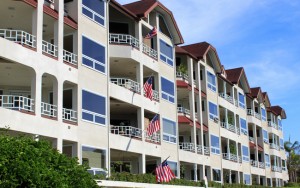By Leah Etling on February 13, 2013 in News
 The results of a study published Tuesday, jointly funded by the National Apartment Association and National Multi-Housing Council, offer one of the most comprehensive looks to date at the size and scope of the nation’s multifamily industry, and the economic impact of its 35 million residents. The survey was conducted by Stephen S. Fuller, Ph.D., George Mason University Center for Regional Analysis.
The results of a study published Tuesday, jointly funded by the National Apartment Association and National Multi-Housing Council, offer one of the most comprehensive looks to date at the size and scope of the nation’s multifamily industry, and the economic impact of its 35 million residents. The survey was conducted by Stephen S. Fuller, Ph.D., George Mason University Center for Regional Analysis.
The numbers are impressive, illuminating how many residual benefits can be attributed to apartment renting. The findings in the study are validation of the construction and development patterns observed by walkable urbanism researcher Chris Leinberger. Renters want urban apartments with services and amenities within easy reach. As he told us last week: “Any list of walkable metro areas that are doing well is also the list of best performing real estate markets.”
The survey looks at major metros Atlanta, Boston, Chicago, Dallas, Denver, Houston, Los Angeles, Miami, New York, Philadelphia, Seattle and Washington, D.C. in detail as to how apartments contribute to their economies. To see state-by-state breakdowns on the number of apartment residents, apartment homes, jobs supported and contribution to statewide economy, visit the Apartments: We Live Here interactive infographic.
Though new construction gets a lot of attention, especially post-recession, don’t overlook the economic boost provided by ongoing maintenance of existing apartment homes. According to Fuller: “Often overlooked as an economic contributor, the industry spent $68 billion operating and maintaining the nation’s 19.3 million apartment homes in 2011 alone. That’s 4.5 times the amount spent on multifamily construction,” he wrote. And as more apartment communities are constructed to meet growing renter demands, those numbers are only going up.
Here’s a quick look at some of the highlights from the study.
Today:
- 34.6 million: number of apartment residents in the United States
- 19.3 million: number of apartment homes in the United States
- $1.1 trillion: total contribution by apartment renters to the national economy
- 25.4 million: number of jobs supported by apartment operations, new construction, and resident spending
- $628.5 billion: disposable income at the discretion of apartment renters
- $421.5 billion: spending by apartment renters on goods and services in 2011
- $182.6 billion: economic impact of ongoing apartment operations
Looking forward:
- 67 million: the number of adults between age 20-34, a demographic most likely to rent, in the U.S. in two years
- 86 percent: Household growth anticipated between 2000 and 2040 without children, typically indicating higher levels of discretionary spending ability
- 300,000: new units that must to be built per year to meet rental demand and replacement needs
The data quantifies what most apartment industry insiders already know – apartment living not only provides a sustainable lifestyle for residents, but for investors and property management firms, too. The vast power of renters to impact their local and national economies is an excellent reminder to consider the multifamily nation as a powerful and vital consumer force.
“Even in one of the worst economic climates we’ve ever seen, the multifamily industry and its 35 million residents contributed more than $1 trillion to the economy,” said NMHC Chairman Thomas S. Bozzuto, CEO, The Bozzuto Group, in a press release. “With up to seven million new renter households forming this decade—almost half of all new households—the dollars and jobs we add to the economy will only grow in magnitude.”
What do the survey results mean for your business?



